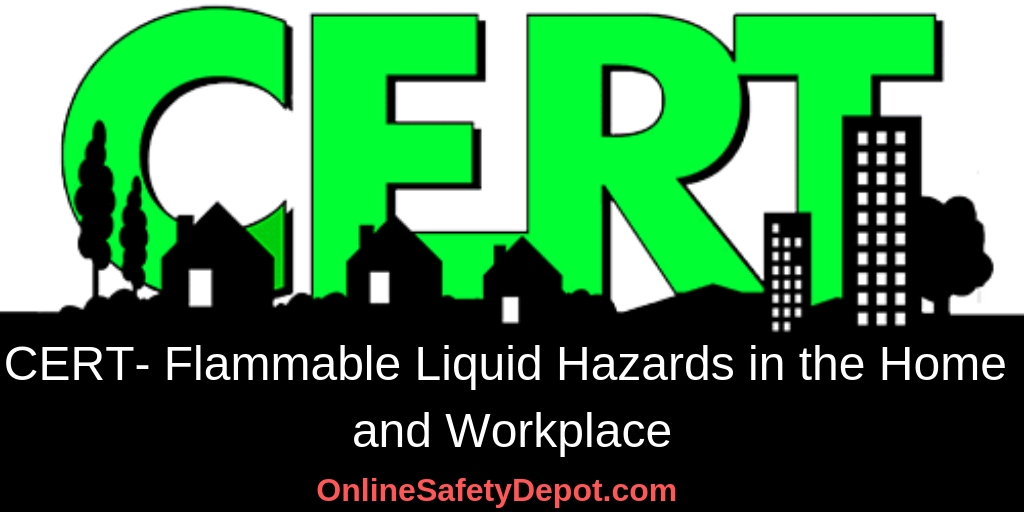CERT- Flammable Liquid Hazards in the Home and Workplace
The Community Emergency Response Team program (CERT) covers three categories of potential fire hazards commonly found in the home and workplace. They are:
1- Electrical Fire Hazards
2- Natural Gas Hazards
3- Flammable Liquid Hazards
The CERT “Fire Hazards in the Home and Workplace” program is designed to help you learn how to understand and identify potential fire hazards, how to avoid or mitigate them, and what to do if an electrical, natural gas, or flammable liquids fire were to occur.
There are several common household or workplace products that are either a combustible liquid or a flammable liquid. Some common flammable liquids/combustible liquids are:
- Gasoline
- Kerosene
- Oil
- Charcoal lighter fluid
- Paint thinners and removers
- Acetone
- Spot removers and cleaning fluids
- Solvents
- Cleaning products
- Alcohols
- Propane
- Propellants use in deodorants, hair sprays, spray paint
Flammable Liquids
Flammable liquids have a flash point or “temperature at which a particular organic compound gives off sufficient vapor to ignite the air”, that is below 100 degrees Fahrenheit. This means they are capable of being easily ignited and burning rapidly, even with an explosive force.
Due to the air-filled vapors, not the liquid itself, ignition can be from a single match being lit, a spark, a burning cigarette, or even a static electrical shock. If ignited, the vapors can produce an explosive force that acts much like a bomb that burns the air in a powerful but short burst.
Combustible Liquids
Combustible liquids have a flash point that is above 100 degrees Fahrenheit. Combustible liquids are “less” dangerous but are still hazardous.
Mitigating Flammable Liquid Hazards
Because flammable liquids can be found in our homes and workplaces, they literally may be all around us. As such, we should know how to identify them and properly and safely store them to mitigate the risks of a fire occurring. The following are some guidelines to consider when storing combustible liquids.
- Identify flammable products by simply reading the product label where such information must be listed.
- Always store flammable liquids and combustible liquids in containers that are approved for such products. For example: Gasoline should be stored in an EPA approved gas container with approved nozzle head.
- When using flammable liquids, do so in a well vented or open area. This will allow the vapors to disburse into the air diluting the concentration. If the vapors build up in an area, they are much more likely to react to a source of heat (flame, spark, etc.) and if ignited, will have a much more forceful reaction.
- Have a fire extinguisher stored in the same area as the flammable liquid is being stored. NOTE: Be sure the fire extinguisher is rated for Class B fires. To better understand what type of fire extinguisher you may need, read our other articles titled, “What Kind of Fire Extinguisher do I Need?” or “Understanding Portable Fire Extinguishers – Use and Limitations”.
- Ensure all lids on the containers are tightly sealed to prevent vapors from escaping out.
- Store containers at room temperature, and away from appliances or other machineries that can act as a heat source or NOTE: All containers should be at least 50 feet away from ignition sources.
- Follow the acronym “LIES” for safe storage of flammable liquids.
LIES Acronym
L= LIMIT
Limit the amount of flammable liquids that are stored in the same area. Should a fire occur, this will minimize the amount of “fuel” it has to burn, resulting in a smaller fire, and more easily extinguished.
I=ISOLATE
Isolate flammable liquids away from any potential heat sources such as machinery, appliances, electrical sources, etc. Enclose them in cabinets or containers and ensure that the area in general is well vented.
E=ELIMINATE
Eliminate any flammable products that you do not need. Depending on the product, you may want to contact your local fire department, auto shop or local waste management facility to learn how to properly dispose of the contents.
S=SEPARATE
Separate incompatible materials from each other by storing flammable liquids away from corrosives products. Some corrosives are also flammable or combustible and the combination should be avoided.
Conclusion
By knowing how to identify potential fire hazards, how to avoid or mitigate them those hazards, and what to do if one of the fire hazards do occur, you are able to help protect yourself, your family, and co-workers from the potential dangers posed by materials that are sensitive to ignition and combustion.
If you want to learn more about this and other topics covered by the Community Emergency Response Team (CERT) program, click HERE

